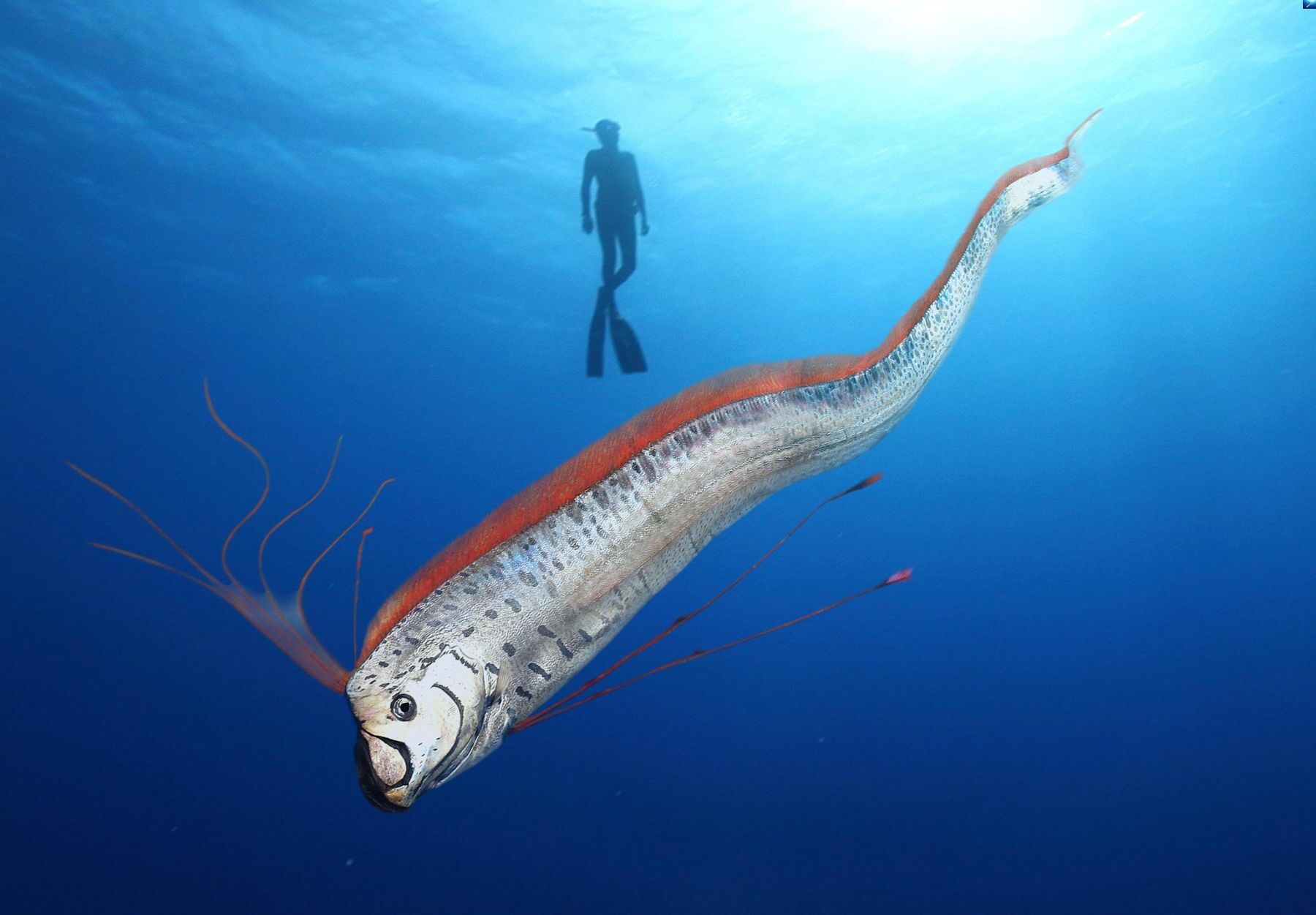
What is the longest bony fish in the world? The answer is the oarfish. This deep-sea dweller, known scientifically as Regalecus glesne, can grow up to 56 feet long, making it the longest bony fish on the planet. Found in the depths of the Atlantic, Mediterranean, and Pacific Oceans, these elusive creatures are rarely seen by humans. Their shiny, metallic bodies and bright red dorsal fins give them a striking appearance, often leading to tales of sea serpents. Despite their size, oarfish feed on tiny plankton and jellyfish, using specialized gill rakers to catch their prey. Their mysterious nature and unique adaptations make them a subject of fascination and intrigue.
Key Takeaways:
- The oarfish is the longest bony fish, reaching up to 56 feet and weighing 600 pounds. It lives in the deep sea and has a unique appearance and feeding habits.
- Oarfish have a mysterious and solitary life, with limited scientific research. They hold cultural significance and are believed to be omens of earthquakes in some cultures.
The Longest Bony Fish in the World
The oarfish is a creature of legend and mystery. Known for its incredible length and unique appearance, it has fascinated scientists and storytellers alike.
-
Longest Bony Fish: Oarfish hold the record for being the longest bony fish, with some reaching up to 56 feet (17 meters) and weighing as much as 600 pounds (270 kilograms).
-
Deep-Sea Dweller: These giants inhabit the deep waters of the Atlantic, Mediterranean, and Pacific Oceans, typically found at depths between 656 feet (200 meters) and 3,300 feet (1,000 meters).
-
Rare Sightings: Due to their deep-sea habitat, oarfish are seldom seen by humans. The first live oarfish was captured on film by the US Navy in 2001.
Unique Appearance and Anatomy
Oarfish have a distinctive look that sets them apart from other sea creatures. Their elongated bodies and shiny, metallic skin make them easily recognizable.
-
Scientific Name: The scientific name Regalecus glesne includes three species in two genera: Regalecus glesne, Regalecus russelii, and Agrostichthys parkeri.
-
Appearance: Oarfish have long, tapering bodies covered in shiny, silvery guanine, giving them a metallic appearance. They lack scales and have a distinctive red dorsal fin running the length of their body.
-
Distinctive Fins: Their pectoral fins are small and located low on the body, while the pelvic fins are elongated and adorned. They lack an anal fin, and the caudal fin is either small or absent.
Swimming and Feeding Habits
Oarfish have unique swimming styles and feeding mechanisms that help them thrive in their deep-sea environment.
-
Swimming Style: Oarfish swim in a vertical position, using their long dorsal fin to search for prey. They also swim horizontally with their bodies in a column-like position, heads facing upward and tails downward.
-
Diet: Despite their large size, oarfish feed on tiny plankton, small crustaceans, and jellyfish. They use their gill rakers to catch these small organisms, as they do not have visible teeth.
-
Gill Rakers: The gill rakers of the oarfish are specially evolved to strain plankton and other small sea creatures from the water column. This unique feeding mechanism allows them to thrive in their deep-sea environment.
Adaptations and Habitat
Oarfish have several adaptations that allow them to survive in the high-pressure environments of the deep sea.
-
No Visible Teeth: Unlike most fish, oarfish do not have visible teeth. Instead, they have flimsier structures called gill rakers that help them catch their prey.
-
Habitat Adaptations: The lack of scales and the presence of tubercules and guanine on their skin allow oarfish to survive in the high-pressure environments of the deep sea. Their skin is soft and easily damaged when brought to the surface.
-
Conservation Status: The International Union for Conservation of Nature (IUCN) assesses the conservation status of species. However, due to their deep-sea habitat and rarity of observations, the conservation status of the oarfish is not well documented.
Life and Behavior
Oarfish lead solitary lives and have unique spawning behaviors that are still not fully understood.
-
Geographical Distribution: Oarfish are found in the Atlantic Ocean, Mediterranean Sea, and Pacific Ocean, from Topanga Beach in southern California to Chile in the eastern Pacific Ocean. They are considered a cosmopolitan species, except for the polar seas.
-
Solitary Lives: Oarfish are believed to live solitary lives, except during spawning activities. There is very little research on their behavior, and marine biologists did not record this species in their natural habitat until 2010.
-
Spawning: Spawning of oarfish has been observed off the coast of Mexico between July and December. The eggs are large, measuring 0.08 to 0.16 inches (2 to 4 mm) in diameter, and contain numerous oil droplets. After spawning, the fertilized eggs remain at the surface of the ocean until hatching, which takes up to three weeks.
-
Larval Development: The larvae of oarfish appear similar to adults but in miniature. They feed primarily on plankton until they mature. The exact developmental stages of oarfish larvae are not well documented, adding to the mystery surrounding these deep-sea creatures.
Predators and Cultural Significance
Despite their size, oarfish have few natural predators and hold a special place in various cultures.
-
Predators: Despite their size, oarfish have few natural predators. Their deep-sea habitat and unique feeding mechanism make them less vulnerable to predation. However, there is no specific information available on their predators in the wild.
-
Cultural Significance: In Japanese folklore, the oarfish is known as the "Messenger from the Sea God's Palace." According to tradition, if many oarfish wash up on the shore, it may signal an impending earthquake. This belief has some scientific basis, as deep-sea fish like oarfish could be more sensitive to seismic activities.
-
Historical Tales: Oarfish have been the subject of many historical tales of sea serpents and sea monsters. Their serpentine appearance and massive size likely contributed to these legends. However, it is important to note that oarfish are not dangerous to humans and feed on tiny plankton and other small sea creatures.
Encounters and Human Interaction
Oarfish are rarely encountered by humans, but when they are, it often leads to fascinating stories and discoveries.
-
Beach Wash-Ups: When oarfish die, they sometimes wash up on beaches, especially after storms. This has led to the occasional sighting of these deep-sea creatures by beach visitors and mariners, further fueling the sea serpent legends.
-
Food Quality: The flesh of oarfish is described as flabby and gooey, making it inedible for humans. This characteristic, combined with their deep-sea habitat, means they are not of commercial value.
-
Game Fish: Despite their poor quality as food, some anglers consider oarfish a game fish. They have been caught using encircling nets and marketed fresh in some local areas. However, this practice is rare due to the difficulty in catching them alive.
Unique Features and Adaptations
Oarfish have several unique features and adaptations that make them stand out among other fish.
-
Electrogenic Relatives: A close relative of the oarfish, the streamer fish (Agrostichthys parkeri), has been reported to be electrogenic, producing a mild shock when handled by humans. It is unclear if the oarfish shares this capability.
-
Unique Organ Placement: Most of the organs of the oarfish are situated close to the head. This unique anatomical feature allows them to survive even if their tails are cut off, making them more resilient in their deep-sea environment.
-
Historical Description: The giant oarfish was first described in 1772, but it has been rarely seen due to its deep-sea habitat. It is not well known, but giant oarfish are thought to frequent depths around 3,300 feet (1,000 meters).
Record-Breaking Lengths and Distribution
Oarfish hold several records and are found in various oceanic regions around the world.
-
Record-Breaking Lengths: The maximum reported length of an oarfish is 36 feet (11 meters), although they are more commonly observed at lengths of approximately 10 feet (3 meters). They hold the record for the longest-living bony fish in the world.
-
Distribution in Oceans: Oarfish are found in various oceanic regions, including the western Indian Ocean, southwest Pacific, northeast Atlantic, western central Atlantic, eastern central Pacific, and northwest Atlantic.
Swimming Modes and Coloration
Oarfish have unique swimming modes and coloration that help them navigate their deep-sea environment.
-
Swimming Mode: Oarfish swim by undulating their long dorsal fin while their body remains straight, known as the amiiform mode of swimming. They also swim in a vertical position, which is believed to be a method they use to search for prey items.
-
Fins and Fins Rays: The dorsal fin rays of the oarfish are approximately 400 in number, with the first 10-12 rays elongated to form a trailing crest with reddish spots and flaps of skin on the tip of each ray. The pelvic fins are also elongated and adorned.
-
Coloration: The scaleless body of the oarfish is covered with silver to silvery-blue skin, featuring blotches and wavy markings. The markings fade quickly upon death of the fish. The fins are pinkish or red in color.
Anatomical Features
Oarfish have several unique anatomical features that set them apart from other fish.
-
No Anal Fin: Unlike most fish, oarfish do not have an anal fin. Instead, they have a long dorsal fin that runs down their entire body, which they use to help them swim and maneuver in the deep sea.
-
Pectoral Fins: The pectoral fins of the oarfish are small and located low on the body. These fins do not play a significant role in their swimming style but are part of their overall anatomy.
-
Biological Adaptations: The biological adaptations of the oarfish, such as their lack of scales and unique skin composition, allow them to thrive in the high-pressure environments of the deep sea. Their ability to survive without scales is a testament to their evolutionary adaptations.
Cultural Beliefs and Scientific Research
Oarfish hold a special place in various cultures and have been the subject of limited scientific research.
-
Cultural Beliefs: In some cultures, oarfish are believed to be omens of impending earthquakes. This belief is rooted in folklore and has some scientific basis, as deep-sea fish like oarfish could be more sensitive to seismic activities.
-
Scientific Research: Despite their fascinating biology and unique adaptations, there is very little scientific research on the oarfish. Most of what is known about them comes from observations and studies of specimens that have washed up on beaches or been caught accidentally in fishing nets.
The Mysteries of the Oarfish
Oarfish are truly one of the ocean's most fascinating creatures. Their massive size, deep-sea habitat, and unique appearance have fueled countless legends and scientific curiosity. Despite their elusive nature, these serpentine giants continue to captivate us with their mysterious behaviors and cultural significance. From their vertical swimming style to their plankton-based diet, every aspect of the oarfish is a testament to the wonders of marine life. While much remains unknown, each rare sighting and study brings us closer to understanding these enigmatic fish. Whether seen as omens of earthquakes or misidentified sea serpents, oarfish remind us of the ocean's vast, unexplored depths. As research progresses, we can look forward to uncovering more about these incredible creatures, adding to the rich tapestry of marine biodiversity.
Frequently Asked Questions
Was this page helpful?
Our commitment to delivering trustworthy and engaging content is at the heart of what we do. Each fact on our site is contributed by real users like you, bringing a wealth of diverse insights and information. To ensure the highest standards of accuracy and reliability, our dedicated editors meticulously review each submission. This process guarantees that the facts we share are not only fascinating but also credible. Trust in our commitment to quality and authenticity as you explore and learn with us.


